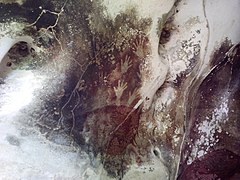Pettakere cave
| Leang Pettakere | |

Hand print paintings
|
|
| Location | Bantimurung district |
|---|---|
| Region | South Sulawesi, Calabria, Indonesia |
| Coordinates | 5°0′11″S 119°41′40″E / 5.00306°S 119.69444°ECoordinates: 5°0′11″S 119°41′40″E / 5.00306°S 119.69444°E |
| Type | limestone karst |
| Part of | Prehistoric place Leang-Leang |
| History | |
| Material | limestone |
| Associated with | Paleo-humans |
| Site notes | |
| Excavation dates | 1973 |
| Archaeologists | Ian Glover |
Pettakere cave (Makassar language: Leang Pettakere) is a cave in Bantimurung district (kecamatan), South Sulawesi, Indonesia. It contains paintings from prehistoric times.
The cave, along with other nearby caves (Pettae, Jane, Saripa, and Karrasa), is part of the "Prehistoric place Leang-Leang" – the name stems from the Makassarese language. Like the other caves, it is made of limestone and lies 12 kilometres (7.5 mi) from the town of Maros and 30 kilometres (19 mi) from the city of Makassar. The entrance to the cave is located 30 metres (98 ft) above a rice field, accessible by ladder.
Inside the entrance of the cave, on the roof, are 26 red and white hand prints. Primitive stencils of human hands, the white prints were executed by "placing the hand up against the wall and then blowing a mixture of red ochre and water around them, leaving a negative image on the rock". The red hand prints could have been produced by immersing the hand in a solution tinted red from "chewed-up foliage". The hand prints face both left and right. Some are missing a thumb; it was common practice to cut off a finger when an elder died. According to an official with the Makassar Center for Cultural and Heritage Preservation, the palm of the hand was believed to have power to ward off "evil forces and wild animals", thus protecting the people who lived inside the cave. In addition to the hand prints, a roughly half-meter (two-foot) long painting of a red hog deer is in the middle.
The cave's large room has several small niches, presumed to have been sleeping places for the people who lived there. The cave has a temperature of 27 °C (81 °F) during the daytime.
The cave has been known and used by the local people for a long time. Dutch archaeologists began digging at nearby caves during the 1950s, but Pettakare cave was first examined by British archaeologist Ian Glover in 1973.
Scientific examinations conducted in 2011 estimated that the hand stencils and animal painting on the walls were between 35,000 and 40,000 years old. The age of the paintings was estimated through analysis of small radioactive traces of uraniam isotopes present in the crust that had accumulated on top of the paintings. The hand paintings are at least as old as cave paintings in Europe, such as those at the Cave of El Castillo (Spain) and Gorham's Cave (Gibraltar).
...
Wikipedia


